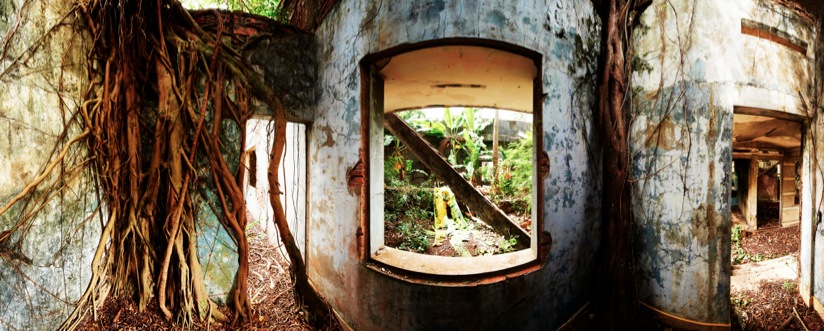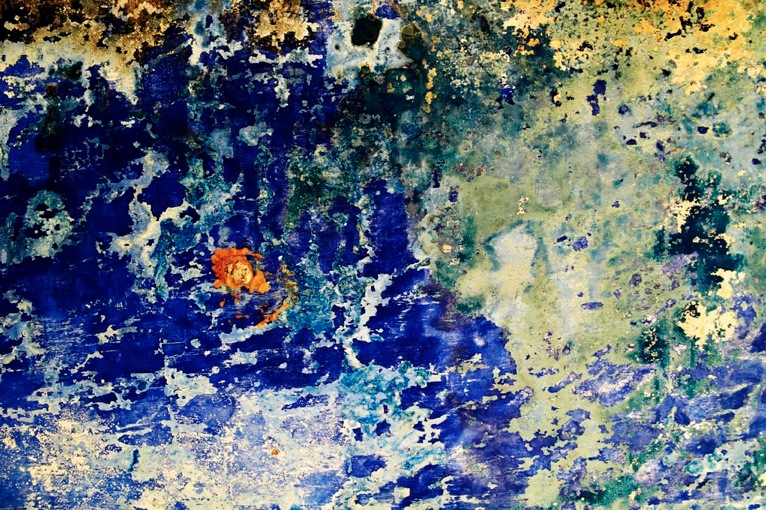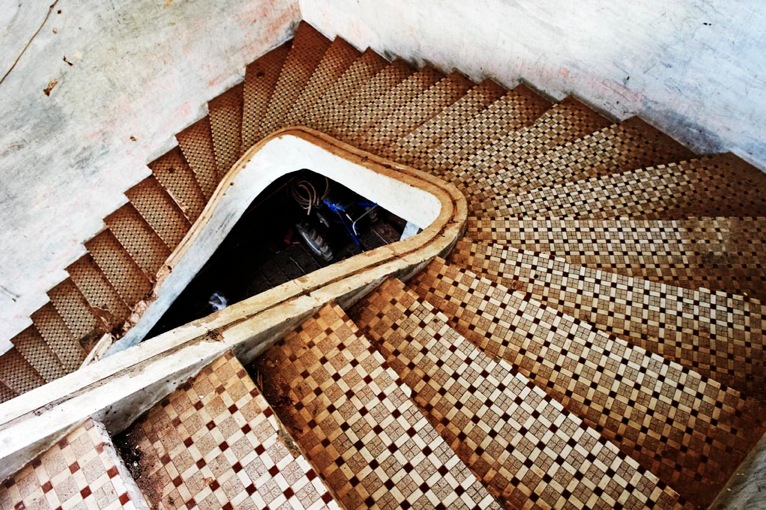Ruins and demons of the Khmer high life
14/02/12 15:03 Archiviato in: Stories
“It’s better not to go into certain old houses; they are haunted”. So says the learned Frenchman studying the ruins of the Kep villas, a village on the Cambodian coast hemmed in between forest-covered hills, palm tree-fringed beaches and swamps. The fences no longer keep any one out. The newer, painted walls surround empty spaces, where even the ruins have been demolished to make way for new building land. Among tall palm trees, thick bushes and canes appear unsettling, gaping geometric constructions: a post-modern Angkor, where vegetation, climbing roots and India-rubber trees cover and devour the walls, framing the gaps of former windows, drawing metaphysical designs on the walls on which mouldy greens and yellows have stained what is left of the blue, ochre and pink decorations beneath.

The traces of colour, the latent forms, fragments of multi-coloured tiles, a staircase leading nowhere like a metaphysical architecture painting from the past.


In the ’20s Kep was “The Jewel of the Côte d’Agathe”, one of the French colonial administration’s favourite destinations. Following independence, in the ’50s and ’60s, Prince Norodom Sihanouk wanted to make it into the Saint-Tropez of South East Asia, the jet-setting haunt of the new elite of the Sangkum Reastr Niyum, or “Popular Socialist Community”. Sihanouk’s movement combined elements of socialism, nationalism, conservatism, Buddhism and populism, almost a precursor for the “illuminated dictatorships” of contemporary Asia. Cultural eclecticism, as seen in the Sangkum modernism of the New Khmer Architecture, combined the style practiced at that time in Europe by Le Corbusier and a reworking of ancient Khmer forms, under the banner of a primitive functionalism to adapt to climate and territory. The master of this style was Cambodian architect Vann Molyvann, behind the Phnom Penh stadium, who created some of his most interesting work in Kep province. Another key figure in the movement was Frenchman Roger Colne, who designed the Kep casino.
The Saint Tropez of the Gulf of Thailand was canonised in one of the films produced and directed by and starring Prince Sihanouk. Kep became the showcase of a new Cambodia: cultured, wealthy, refined, and apparently far from the war in Indochina.
The title of that film, Crepuscule, anticipates the dark years to come. In March 1970 General Lon Nol, backed by the United States, deposed Sihanouk and Cambodia entered the Great Game of war. This in turn strengthened the movement of the Khmer Rouge. On 31st May of that year, the architect Colne was killed in an ambush by Pol Pot’s followers while travelling in the Kep province with a group of journalists. His body has never been found. Hell was unleashed in Cambodia: Lon Nol’s dictatorship, those “3 years, 8 months, 20 days” of horror of the Khmer Rouge, the Vietnamese invasion (or liberation), the civil war.
During those years, the Kep villas were at the heart of the battlefield. In reality, despite the bullet holes of all sizes in the walls and the stories, now recited parrot-fashion by the locals, the clashes that occurred here were limited. The Khmer Rouge never destroyed Kep’s modernist villas with the same determination they gave to colonial buildings. Perhaps because these pared-down, functional concrete blocks were reminiscent of others in the Soviet Union. Perhaps because, unconsciously, they felt their Khmer spirit. Perhaps because they just didn’t understand them. So how did they end up looking this way? “The good old technique of vampirization”, says the Frenchman, who has studied them. For the local population they provided a reserve of all sorts of materials, especially in the years following the fall of the Khmer Rouge, when people were dying of poverty and anything could mean the difference between life and death.
In those years, the casino was first converted into a market, then a stable, then a stable and latrine for a mini slum that had grown up all around. Tangled roots now grow on what used to be the corniche and the interior. The present is much more visible now: huts lean against the ruins or on top of what is left of the floor of an entrance hall, cows drink from the puddles leaking out of cisterns adjacent to what must have been a bathroom. One of the few buildings still intact belonged to Sihanouk’s mother, Princess Sisowath Kossamak Nearireath. Now it’s a tourist attraction. The one dollar entrance fee is collected by a guardian sporting a kind of military uniform who tells that in 1982 the palace was at the centre of a battle between Vietnamese and Khmer Rouge fighters. A regular face is local guide Mr Oeu. He says that as a child he lived nearby and saw Sihanouk’s children playing, but never dared approach them. Beyond the walls, the house is a mere shell: only an elegant spiral staircase to the first floor still stands. From the terrace you can see the long concrete structure where the Princess Mother embarked on trips to the islands off Kep. The back of the house is half destroyed, of the kitchen only a wall remains blackened by the fires lit for cooking: the place’s function is the same, the methods and equipment have changed.
“It feels like these buildings are weeping”, says the Frenchman. And the ghosts of the villas’ former occupants feed on this pain. In the magical Khmer world, arb, or demons, are an immanent presence in nature. They manifest themselves at night, when they go on the prowl for human beings to suck their blood or devour them. In their metamorphosis into a portal to an occult world, the ruins of Kep, like those of Angkor, become that space-time machine described by French anthropologist Marc Augé in Time in Ruins: they reveal a sense of a time that does not feature in the history books. A pure time, with no fixed dates, absent from our world of images, effigies and reconstructions, from our violent world whose rubble no longer has the time to turn to ruins. “The rubble accumulated by recent history and the ruins creating out of the past do not resemble one another. There is a big difference between the historical time of destruction, which reveals the folly of history, and pure time, time in ruin, the ruins of time that has lost history and that history has lost”.
This lost time is recreated by talking about it and talking of the meaning of life on the sea shore, opposite Knai Bang Chatt, a boutique hotel built on the ruins of a ’70s villa designed by one of Le Corbusier’s pupils. It’s not down to the restoration, which is good, but to the implied idea of luxury and escapism, the mental dimension where we continue to seek refuge.
“If you want to die looking at the sea, then look at the forest”, says the hotel’s owner. In Kep, the desire to flee one’s demons is fierce.

The traces of colour, the latent forms, fragments of multi-coloured tiles, a staircase leading nowhere like a metaphysical architecture painting from the past.


In the ’20s Kep was “The Jewel of the Côte d’Agathe”, one of the French colonial administration’s favourite destinations. Following independence, in the ’50s and ’60s, Prince Norodom Sihanouk wanted to make it into the Saint-Tropez of South East Asia, the jet-setting haunt of the new elite of the Sangkum Reastr Niyum, or “Popular Socialist Community”. Sihanouk’s movement combined elements of socialism, nationalism, conservatism, Buddhism and populism, almost a precursor for the “illuminated dictatorships” of contemporary Asia. Cultural eclecticism, as seen in the Sangkum modernism of the New Khmer Architecture, combined the style practiced at that time in Europe by Le Corbusier and a reworking of ancient Khmer forms, under the banner of a primitive functionalism to adapt to climate and territory. The master of this style was Cambodian architect Vann Molyvann, behind the Phnom Penh stadium, who created some of his most interesting work in Kep province. Another key figure in the movement was Frenchman Roger Colne, who designed the Kep casino.
The Saint Tropez of the Gulf of Thailand was canonised in one of the films produced and directed by and starring Prince Sihanouk. Kep became the showcase of a new Cambodia: cultured, wealthy, refined, and apparently far from the war in Indochina.
The title of that film, Crepuscule, anticipates the dark years to come. In March 1970 General Lon Nol, backed by the United States, deposed Sihanouk and Cambodia entered the Great Game of war. This in turn strengthened the movement of the Khmer Rouge. On 31st May of that year, the architect Colne was killed in an ambush by Pol Pot’s followers while travelling in the Kep province with a group of journalists. His body has never been found. Hell was unleashed in Cambodia: Lon Nol’s dictatorship, those “3 years, 8 months, 20 days” of horror of the Khmer Rouge, the Vietnamese invasion (or liberation), the civil war.
During those years, the Kep villas were at the heart of the battlefield. In reality, despite the bullet holes of all sizes in the walls and the stories, now recited parrot-fashion by the locals, the clashes that occurred here were limited. The Khmer Rouge never destroyed Kep’s modernist villas with the same determination they gave to colonial buildings. Perhaps because these pared-down, functional concrete blocks were reminiscent of others in the Soviet Union. Perhaps because, unconsciously, they felt their Khmer spirit. Perhaps because they just didn’t understand them. So how did they end up looking this way? “The good old technique of vampirization”, says the Frenchman, who has studied them. For the local population they provided a reserve of all sorts of materials, especially in the years following the fall of the Khmer Rouge, when people were dying of poverty and anything could mean the difference between life and death.
In those years, the casino was first converted into a market, then a stable, then a stable and latrine for a mini slum that had grown up all around. Tangled roots now grow on what used to be the corniche and the interior. The present is much more visible now: huts lean against the ruins or on top of what is left of the floor of an entrance hall, cows drink from the puddles leaking out of cisterns adjacent to what must have been a bathroom. One of the few buildings still intact belonged to Sihanouk’s mother, Princess Sisowath Kossamak Nearireath. Now it’s a tourist attraction. The one dollar entrance fee is collected by a guardian sporting a kind of military uniform who tells that in 1982 the palace was at the centre of a battle between Vietnamese and Khmer Rouge fighters. A regular face is local guide Mr Oeu. He says that as a child he lived nearby and saw Sihanouk’s children playing, but never dared approach them. Beyond the walls, the house is a mere shell: only an elegant spiral staircase to the first floor still stands. From the terrace you can see the long concrete structure where the Princess Mother embarked on trips to the islands off Kep. The back of the house is half destroyed, of the kitchen only a wall remains blackened by the fires lit for cooking: the place’s function is the same, the methods and equipment have changed.
“It feels like these buildings are weeping”, says the Frenchman. And the ghosts of the villas’ former occupants feed on this pain. In the magical Khmer world, arb, or demons, are an immanent presence in nature. They manifest themselves at night, when they go on the prowl for human beings to suck their blood or devour them. In their metamorphosis into a portal to an occult world, the ruins of Kep, like those of Angkor, become that space-time machine described by French anthropologist Marc Augé in Time in Ruins: they reveal a sense of a time that does not feature in the history books. A pure time, with no fixed dates, absent from our world of images, effigies and reconstructions, from our violent world whose rubble no longer has the time to turn to ruins. “The rubble accumulated by recent history and the ruins creating out of the past do not resemble one another. There is a big difference between the historical time of destruction, which reveals the folly of history, and pure time, time in ruin, the ruins of time that has lost history and that history has lost”.
This lost time is recreated by talking about it and talking of the meaning of life on the sea shore, opposite Knai Bang Chatt, a boutique hotel built on the ruins of a ’70s villa designed by one of Le Corbusier’s pupils. It’s not down to the restoration, which is good, but to the implied idea of luxury and escapism, the mental dimension where we continue to seek refuge.
“If you want to die looking at the sea, then look at the forest”, says the hotel’s owner. In Kep, the desire to flee one’s demons is fierce.



